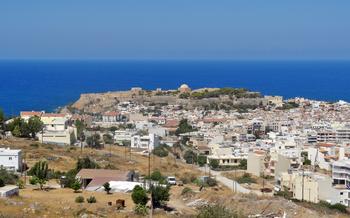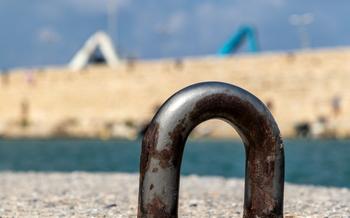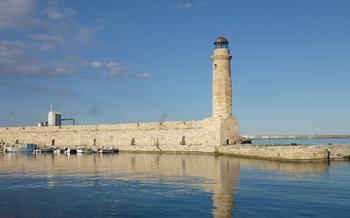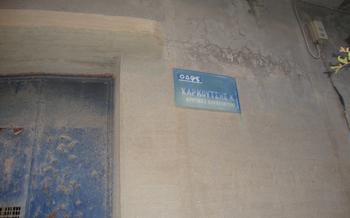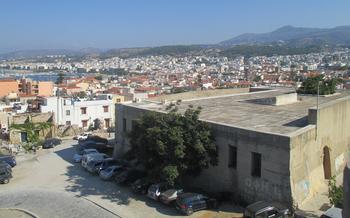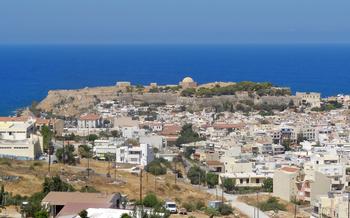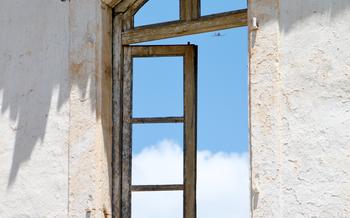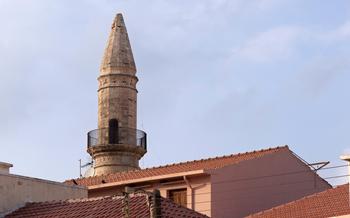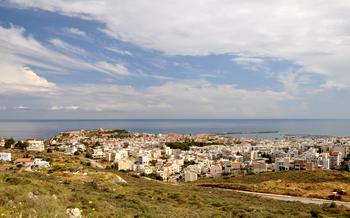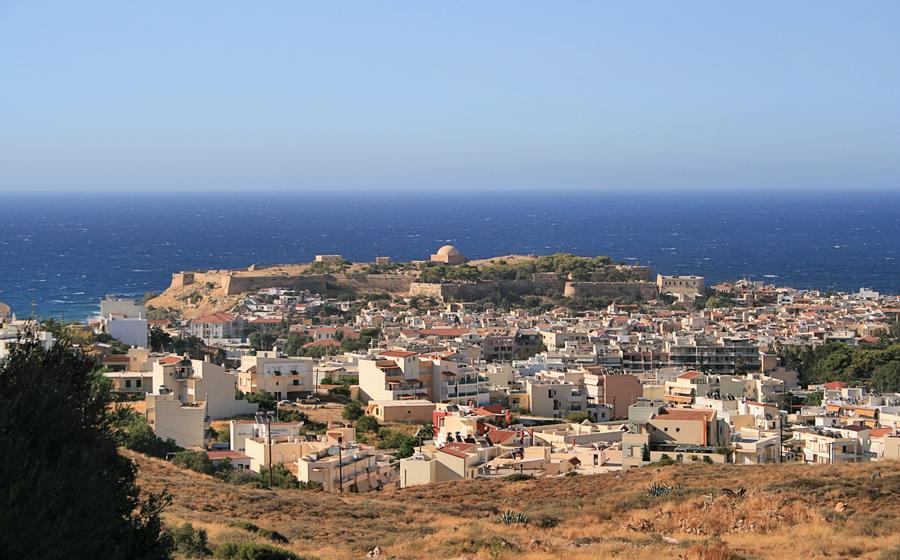
Lappa Archaeological Site
- Lappa Archaeological Site: A Journey Through Time
- Unveiling the Past: A Walk Through the Ancient City
- The Acropolis: A Majestic Panorama
- The Odeon: A Stage for Ancient Performances
- The Roman Baths: A Sanctuary of Relaxation
- Early Christian Basilica: A Testament to Religious Transformation
- The Venetian Fortress: A Symbol of Resilience
- The Archaeological Museum: A Treasure Trove of Discoveries
- Festivals and Events: Bringing History to Life
- Hiking Trails: Exploring the Natural Beauty
- Local Cuisine: A Culinary Adventure
- Nearby Beaches: A Coastal Paradise
- Day Trips from Rethymno: Expanding Your Horizons
- Photography Opportunities: Capturing the Essence
- Insider Tip: Unveiling Hidden Secrets
Lappa Archaeological Site: A Journey Through Time
Historical significance: Lappa, an ancient city-state in Crete, holds a significant place in Greek history. Founded in the 7th century BC by Dorian Greeks, it flourished during the Classical and Hellenistic periods. Lappa's strategic location, fertile lands, and access to the sea contributed to its prosperity and cultural influence.
Location: Situated about 20 kilometers southeast of Rethymno, Lappa's archaeological site is nestled amidst picturesque olive groves and rolling hills. It offers a tranquil ambiance, inviting visitors to explore the remnants of this once-thriving city.
What to expect: As you approach the site, you'll be greeted by the imposing Venetian fortress, a testament to the region's rich history. Inside the fortress walls, you'll discover a treasure trove of ancient ruins, including fortified walls, temples, public buildings, residential areas, and an impressive acropolis. Prepare to be captivated as you journey through time, uncovering the secrets of Lappa's glorious past.
Unveiling the Past: A Walk Through the Ancient City
As you enter the Lappa Archaeological Site, you will be greeted by the imposing fortified walls that once protected the city. These massive structures, built with large limestone blocks, stand as a testament to the engineering prowess of the ancient Lapaeans.
Within the walls, you will find a treasure trove of ancient ruins, each telling its own story about the city's past. Temples and religious sites, such as the Temple of Apollo and the Sanctuary of Asclepius, offer a glimpse into the spiritual beliefs of the Lapaeans.
Public buildings, such as the Agora, where citizens gathered for trade and political discussions, and the Odeon, a small theater used for musical and dramatic performances, provide insights into the civic and cultural life of the city.
The residential areas, with their well-preserved houses and courtyards, offer a glimpse into the everyday lives of the Lapaeans. You can almost imagine the hustle and bustle of the ancient city as you walk through these streets, lined with shops, workshops, and homes.
The Acropolis: A Majestic Panorama
As you ascend the ancient path leading to the acropolis, a breathtaking panorama unfolds before your eyes. Perched atop a hill, the acropolis offers unparalleled views of the surrounding countryside, stretching from the sparkling Mediterranean Sea to the verdant valleys and distant mountain ranges. The acropolis served as the heart of ancient Lappa, a place of religious devotion, political power, and cultural significance.
The acropolis is fortified with massive walls and defensive structures, a testament to its strategic importance. These fortifications, built with precision and strength, protected the city from invaders and ensured its autonomy. As you explore the acropolis, you'll encounter remnants of ancient temples and religious sites, where the people of Lappa once worshipped their gods and goddesses. These sacred spaces, with their intricate carvings and imposing altars, offer a glimpse into the spiritual beliefs and practices of the ancient Greeks.
Among the most notable structures on the acropolis is the Temple of Apollo, dedicated to the Greek god of music, poetry, and healing. The temple's graceful columns and well-preserved pediments hint at the grandeur and artistry that once adorned this sacred site. Another significant landmark is the Odeon, a small theater used for musical and theatrical performances. With its excellent acoustics and intimate setting, the Odeon provided a venue for cultural expression and entertainment.
The Odeon: A Stage for Ancient Performances
The Odeon of Lappa is an impressive structure that once served as a venue for various artistic and cultural performances. Built during the Roman period, it is a testament to the city's cultural significance in ancient times.
Architectural Features:
The Odeon is a semi-circular building with a diameter of approximately 20 meters, featuring a stepped seating area that could accommodate up to 300 spectators. The stage, located at the center of the structure, is surrounded by a raised platform and decorated with niches and columns.
Purpose and Significance:
The Odeon was primarily used for musical performances, theatrical plays, and recitals. It served as a gathering place for the community to enjoy artistic expressions, promote cultural exchange, and foster a sense of shared identity.
Acoustical Marvels:
The Odeon's design incorporates remarkable acoustical features that enhance the quality of sound within the theater. The curved shape of the seating area and the placement of the stage create an optimal environment for projecting and amplifying the voices of performers, ensuring that their words and melodies reached every corner of the auditorium.
Performances and Events:
In ancient times, the Odeon hosted a variety of performances, including dramas, comedies, musical concerts, and poetry recitals. Local artists and traveling troupes would grace the stage, entertaining the citizens of Lappa with their talents. The Odeon also served as a venue for official ceremonies, public announcements, and religious festivals.
The Roman Baths: A Sanctuary of Relaxation
Amidst the ruins of Lappa, the Roman baths stand as a testament to the city's grandeur and its citizens' appreciation for leisure and well-being. These opulent facilities were once a sanctuary of relaxation and rejuvenation, where the Romans indulged in bathing rituals that held deep social and cultural significance.
The baths were constructed during the 2nd century AD and comprised various chambers designed for different purposes. The frigidarium, or cold room, allowed bathers to cool off after a strenuous workout or a hot bath. The tepidarium, or warm room, served as a transition zone between the cold and hot chambers, preparing the body for the intense heat of the caldarium, or hot room.
The caldarium was the centerpiece of the baths, where bathers could soak in steaming hot water and enjoy the therapeutic benefits of the thermal springs that fed the complex. The room's walls were lined with marble and decorated with intricate mosaics depicting scenes from mythology and nature.
After a relaxing soak in the hot springs, bathers could move to the apodyterium, or dressing room, to change into dry clothes. The baths also featured a palaestra, or exercise area, where visitors could engage in physical activities such as wrestling, boxing, and weightlifting.
The Roman baths of Lappa are remarkably well-preserved, offering a glimpse into the bathing culture and social customs of the ancient Romans. Visitors can still admire the intricate mosaics, vaulted ceilings, and marble benches that once adorned these opulent facilities.
Early Christian Basilica: A Testament to Religious Transformation
As the Roman Empire embraced Christianity, the city of Lappa underwent a profound religious transformation. In the 5th century AD, a magnificent Early Christian basilica was constructed, symbolizing the growing influence of the new faith. This impressive edifice served as a place of worship and community gathering for the early Christian community.
The basilica's architectural features reflect the transition from pagan to Christian traditions. Its spacious interior, divided by rows of columns, allowed for large congregations to gather. The apse, a semi-circular recess at the eastern end, housed the altar and was adorned with intricate mosaics depicting biblical scenes.
The basilica's mosaic floors are particularly noteworthy, showcasing vibrant colors and intricate designs. These mosaics not only served as decorative elements but also conveyed religious messages and stories from the Bible. They depict scenes from the life of Jesus, as well as symbolic representations of saints and martyrs.
The Early Christian basilica in Lappa stands as a testament to the city's rich religious history and the enduring legacy of Christianity in the region. Its well-preserved remains offer a glimpse into the beliefs and practices of the early Christian community and provide valuable insights into the evolution of religious architecture in Crete.
The Venetian Fortress: A Symbol of Resilience
Perched atop the hill overlooking the city, the Venetian Fortress stands as a testament to Rethymno's rich and tumultuous history. Originally constructed by the Venetians in the 16th century as a means to protect against Ottoman attacks, this remarkable fortress has weathered the storms of time, bearing witness to countless battles and sieges.
The Venetian Fortress is a magnificent example of military architecture, boasting sturdy fortifications and defensive features that once made it virtually impregnable. Explore the labyrinthine network of ramparts, bastions, and turrets, marveling at the ingenuity and craftsmanship that went into its construction.
As you wander through the fortress, immerse yourself in the historical significance that permeates every stone. Learn about the heroic resistance of the Rethymniots against the Ottoman invaders, and the pivotal role the fortress played in shaping the destiny of the city.
From the ramparts, revel in the panoramic views that stretch across the city, the azure waters of the Mediterranean Sea, and the verdant countryside beyond. Capture the essence of Rethymno, a city where history, culture, and natural beauty converge in perfect harmony.
The Archaeological Museum: A Treasure Trove of Discoveries
The Archaeological Museum of Rethymno is a treasure trove of artifacts and discoveries from the Lappa Archaeological Site and the surrounding area. It houses an impressive collection of pottery, sculptures, inscriptions, and other artifacts that shed light on the rich history and culture of ancient Lappa and the wider region.
The museum's exhibits provide visitors with a glimpse into the daily life and customs of the ancient inhabitants of Lappa. Visitors can admire intricate pottery adorned with colorful designs, marvel at finely crafted sculptures depicting gods, goddesses, and mythical creatures, and decipher ancient inscriptions that reveal insights into the political, religious, and social aspects of life in ancient Greece.
Interactive exhibits and displays bring the past to life, allowing visitors to engage with the artifacts and learn more about the history of the region. The museum also hosts educational programs and workshops, providing opportunities for visitors to delve deeper into the fascinating world of ancient Lappa.
Festivals and Events: Bringing History to Life
Lappa's rich history and cultural heritage are celebrated through a vibrant calendar of festivals and events that bring the ancient city to life. Immerse yourself in the spirit of the past as you witness historical reenactments, traditional music and dance performances, and art exhibitions that showcase the region's unique identity.
Join the locals in celebrating the annual Lappa Festival, a grand event that transports visitors back in time with authentic costumes, traditional crafts, and delectable local cuisine. Experience the magic of ancient theater as actors bring to life scenes from Greek mythology and history in the atmospheric setting of the Odeon.
Throughout the year, Rethymno hosts a variety of cultural events that showcase the region's rich traditions. From the vibrant Rethymno Carnival, with its colorful parades and lively music, to the Cretan Wine Festival, celebrating the island's renowned viticulture, there's always something to experience.
Indulge in the flavors of traditional Cretan cuisine at local tavernas and restaurants, where you can savor mouthwatering dishes prepared with fresh, local ingredients and infused with the flavors of the Mediterranean. Don't miss the opportunity to sample the region's famous olive oil, a liquid gold that has been prized for centuries.
As the sun sets over the Mediterranean Sea, find a spot along the picturesque Venetian harbor and soak in the magical atmosphere. The warm glow of the evening light casts a golden hue over the ancient fortress and the sparkling waters, creating a truly unforgettable moment.
Hiking Trails: Exploring the Natural Beauty
Picturesque Landscapes:
Immerse yourself in the breathtaking natural beauty surrounding the Lappa Archaeological Site. Wander through olive groves and vineyards, marvel at the rugged mountain landscapes, and soak in the panoramic views of the countryside. The trails offer a unique perspective on the region's rich history and cultural heritage.
Ancient Paths and Routes:
Follow in the footsteps of ancient travelers as you explore the network of paths and routes that crisscross the area. These ancient pathways once connected villages, farms, and religious sites, providing a glimpse into the daily lives of the people who inhabited this region centuries ago.
Olive Groves and Vineyards:
The region is renowned for its production of olive oil and wine. As you hike through the countryside, you'll pass by olive groves and vineyards, where you can learn about the traditional farming methods and sample the local produce. Enjoy the shade of the olive trees and savor the sweet aroma of ripening grapes.
Stunning Views of the Countryside:
The hiking trails reward you with breathtaking views of the surrounding countryside. From hilltop vantage points, you can gaze upon the patchwork of fields, the shimmering sea in the distance, and the majestic mountains that form the backdrop of this picturesque region.
Local Cuisine: A Culinary Adventure
Rethymno's culinary scene is a vibrant tapestry of traditional Cretan flavors and Mediterranean influences. The city's restaurants and tavernas offer a delectable array of dishes, showcasing the freshest local ingredients and showcasing the region's rich culinary heritage.
Indulge in mouthwatering dishes such as "dakos," a traditional Cretan salad made with barley rusks, tomatoes, and feta cheese, and "gamopilafo," a hearty wedding pilaf with lamb or chicken. Sample the succulent seafood catches of the day, grilled to perfection and paired with a glass of local wine.
Don't miss the opportunity to savor the region's renowned olive oil, a staple of the Cretan diet. Drizzle it over fresh salads, bread, or grilled vegetables to enhance their flavors.
For a truly immersive culinary experience, venture into the charming alleys of the Old Town and seek out the hidden tavernas frequented by locals. Here, you'll find authentic dishes prepared with love and passion, using traditional recipes passed down through generations.
A culinary adventure in Rethymno promises tantalizing taste sensations and a deeper appreciation for the rich gastronomic traditions of Crete.
Nearby Beaches: A Coastal Paradise
Rethymno's coastal region is a treasure trove of pristine waters, sandy beaches, and secluded coves. Just a short drive from the city, you can immerse yourself in the crystal-clear waters of the Mediterranean Sea and bask in the warm Cretan sun. Whether you prefer lounging on a sun-kissed beach, enjoying water sports, or savoring fresh seafood delicacies, Rethymno's nearby beaches offer a perfect escape.
The beaches of Rethymno are diverse, catering to every traveler's preference. From the lively and organized beaches with sunbeds, umbrellas, and water sports facilities to the secluded and tranquil coves where you can find your own private paradise, there's a beach for everyone.
For those seeking adventure, the beaches of Rethymno offer a range of water sports activities, including snorkeling, diving, windsurfing, and kitesurfing. Explore the vibrant underwater world of the Mediterranean Sea, teeming with colorful marine life, or ride the waves and feel the thrill of the wind in your hair.
After a day of sun, sea, and sand, indulge in the culinary delights of Rethymno's beachfront tavernas and bars. Savor the freshest seafood dishes, prepared with local ingredients and traditional recipes, while enjoying the stunning views of the Mediterranean Sea.
Day Trips from Rethymno: Expanding Your Horizons
Venture beyond the city limits of Rethymno and embark on a journey of discovery to neighboring villages and hidden gems.
Just a short drive from Rethymno, you'll find a wealth of charming villages, each with its unique character and history. Explore the picturesque village of Margarites, renowned for its pottery tradition, and admire the intricate ceramics and handicrafts created by local artisans. Step back in time as you wander through the narrow streets of Spili, where Venetian architecture blends seamlessly with traditional Cretan charm. Discover the scenic village of Bali, nestled along the stunning coastline, and immerse yourself in the tranquility of its secluded coves and crystal-clear waters.
Rethymno's surroundings are also home to a wealth of ancient sites and monasteries that offer a glimpse into the region's rich past. Visit the ancient city of Eleutherna, with its impressive ruins and well-preserved mosaics, and learn about the significant role it played in Minoan and Classical Greek history. Explore the Arkadi Monastery, a symbol of Cretan resistance against Ottoman rule, and admire its beautiful architecture and poignant history. Delve into the depths of the Melidoni Cave, with its stalactites and stalagmites creating a breathtaking natural spectacle.
As you venture further afield, you'll discover hidden gems and local traditions that offer a glimpse into the authentic Cretan way of life. Visit the traditional villages of Anogia and Zoniana, renowned for their skilled craftsmanship and vibrant folklore. Experience the warmth and hospitality of the locals as you savor delicious homemade dishes and engage in lively conversations. Discover the hidden beaches of Preveli and Damnoni, where pristine waters meet golden sands, creating a paradise for relaxation and adventure.
Don't miss the opportunity to embark on scenic drives that offer panoramic views of the surrounding countryside. Wind your way through the winding roads, passing by olive groves, vineyards, and traditional villages perched on hilltops. Take advantage of the numerous viewpoints along the way to capture breathtaking vistas of the Cretan landscape, the shimmering Mediterranean Sea, and the majestic White Mountains.
Photography Opportunities: Capturing the Essence
Lappa, with its ancient ruins, picturesque landscapes, vibrant street scenes, and stunning sunsets over the Mediterranean Sea, is a photographer's paradise.
Lenses can capture the grandeur of the ancient city walls, the intricate details of the mosaics in the Roman baths, and the serene beauty of the Early Christian Basilica. The Acropolis offers panoramic views that stretch for miles, showcasing the rolling hills, olive groves, and sparkling blue sea.
Photographers can capture the essence of Lappa's vibrant culture by capturing the local people going about their daily lives, the colorful markets, and the traditional festivals.
The best time to capture the magic of Lappa is during the golden hours of sunrise and sunset, when the warm light casts a golden glow on the ancient ruins and the surrounding landscape.
For those seeking unique perspectives, venturing off the beaten path often leads to hidden gems. A short hike up the surrounding hills reveals breathtaking views of the entire site, while exploring the narrow streets of the old town unveils charming corners and hidden courtyards.
A camera becomes a time machine in Lappa, capturing the essence of a place where history and natural beauty intertwine.
Insider Tip: Unveiling Hidden Secrets
Beyond the main attractions, Lappa and its surroundings offer a wealth of hidden gems waiting to be discovered. For an authentic and immersive experience, seek out the secret paths and viewpoints that provide unique perspectives on the ancient city and the surrounding landscapes. Engage with local guides who can share their insights and stories, leading you to off-the-beaten-track tavernas serving delicious local cuisine. Explore hidden beaches and natural wonders that remain untouched by the crowds, creating lasting memories of your journey through time.

